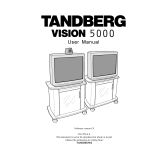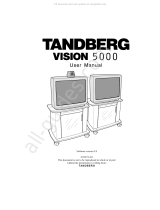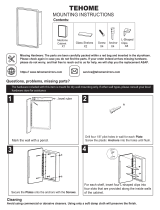Page is loading ...

Assembly and Installation Instructions
for the
AudioScience Microphone
TANDBERG
D 50053, Rev 5.0

Assembly and Installation Instructions
for the AudioScience Microphone
D50053, Revision 5.0
Page
1
AudioScience Microphone Parts Listing
Before proceeding, please ensure that the following list of parts was received with your new
AudioScience Microphone package. If any part is missing or damaged, contact your
TANDBERG Representative to arrange for a replacement.
Q ty Part Description Present?
1
Ac ry li c T op De fl ec to r F i t t e d Wit h M i c r o p h o n e A s s e m b l y
1
Rea r D e fl ec t or
4
C a b l e S u s p e n s i o n A s s e m b l ies
2
Sa f et y C a b l e A s se m bl i es
4
9/1 6” C ei li n g T rac k C l ip s
4
15 / 16 ” C e il in g T r ac k C l ip s
4
!”-2 0 x 1 ” E y e B o l t s
2
1/ 4 U n i v e r s a l S n a p H o ok s
1
4 7 ' P l e n u m R a t e d M i c r o p h o n e C a b l e As s e m b l y
6
N y l o n W a s h e r s
6
S h o u l d e r S c r e w s
10
Wh it e Ca b l e T i e s
1
20 F oo t L en g th of "Ba i li ng " W i re
1
Bottle o f Brill i anize P l a stics C l eaner
1
So f k l o t h T o w el
1
Ass emb ly a nd I ns t al l at i on I ns t ru c ti o ns
Tools Required for Assembly and Installation
• Step ladder (To suit ceiling height)
• Wire cutter
• Knife or other tool to notch the ceiling tiles
• Any tools required to snake cable through the wall (if desired)

Assembly and Installation Instructions
for the AudioScience Microphone
D50053, Revision 5.0
Page
2
Installation Considerations
1. The standard hardware included with the microphone is intended to be clipped to ceiling
tracks with the standard inverted “T” shaped cross-section, and with the horizontal part of
that “T” to be either 9/16” (14 mm) or 15/16” (24 mm) in width. Also, the Ceiling should be
located at a distance between 8 feet (2.4m) and 10.5 feet (3.2m) from the floor. For ceiling
arrangements other than those listed above, four eyebolts are included to allow the
microphone assembly to be fastened to the ceiling with chains, rope, or other hanging
implements. TANDBERG also offers the AudioScience Comprehensive Mounting Kit. This
kit includes anchors and hangings for ceilings ranging in height from 7.5 feet (2.3m) to 16 feet
(4.9m) and should be suitable for nearly all-ceiling types. Consult with your TANDBERG
Dealer to order one of these kits if necessary.
2. The standard cable included with the microphone is 47 feet (14.4 meters) long and plenum
rated to comply with fire code regulations. This allows the microphone to be mounted up to
about 30 “ceiling feet” (9.2 meters) away from the system. If the microphone is mounted
further away, additional cable needs to be ordered. This cable is available in several standard
lengths and can be ordered from your local TANDBERG Representative.
3. When mounted at the recommended height, the microphone assembly has a horizontal pickup
range of about 14 feet (4.3 meters). This means that all seating positions should be within this
range of the microphone capsule. If there are substantial numbers of desired seating positions
outside this area, then additional microphones may need to be installed.
4. The microphone cable should be routed from the microphone on the ceiling to the system on
the floor in an aesthetic manner, such as within a conduit or wall “punch-out”.
5. The AudioScience microphone is currently limited for use on the TANDBERG Educator,
TANDBERG HCSIII, TANDBERG Vision 800, TANDBERG Vision 2500, TANDBERG
Vision 5000, TANDBERG vision 6000, TANDBERG vision 7000, and other approved
systems. Other applications will be documented, as they become available.

Assembly and Installation Instructions
for the AudioScience Microphone
D50053, Revision 5.0
Page
3
Selecting a Mounting Location
The mounting location of the AudioScience microphone can be determined through the
application of five principles. These principles are to be used as a general guide as to locating the
microphone. Adherence to these principles will allow the AudioScience microphone to function
at its highest potential. If, due to other concerns, the microphone has to be mounted in a less than
ideal position or manner, it will still function, and may function quite well, but not as well as it is
capable of.
1. All desirable seating positions should be within 14 horizontal feet (4.3 meters) of the
microphone capsule, with an unobstructed line of sight to the microphone capsule.
2. The supplied hardware is for mounting the microphone to ceilings that are between 8 feet
(2.4m), and 10.5 feet (3.2m) high. With those ceiling heights, the bottom of the rear deflector
will be between 6.5 feet (2m) and 9 feet (2.7m) above the floor. If the microphone needs to
be hung in rooms with ceiling heights greater or less than this recommended range, either
order the AudioScience Comprehensive Mounting Kit, or arrange some sort of alternative
mounting system.
3. All undesirable noise sources should be blocked from reaching the microphone capsule by one
or both boundaries of the microphone.
Selecting a mounting location:
Undesirable noise sources
Air Duct Air Duct Air Duct
Bad Good Best

Assembly and Installation Instructions
for the AudioScience Microphone
D50053, Revision 5.0
Page
4
4. The microphone should be mounted far enough away from the videoconferencing system such
that one or both boundaries of the microphone are between the microphone element and the
loudspeakers of the videoconferencing system to prevent coupling of the direct sound from
the speakers into the microphone element.
Bad Good Best
Table
Loudspeaker
Videoconferencing
System
Selecting a mounting location:
Minimum Distance from Videoconferencing system
5. The mounting holes of the microphone boundary must be directly under a ceiling track to
allow for mounting hardware. Additionally, to allow for easier changing of lighting tubes or
bulbs, the microphone should not be mounted where the microphone blocks these items. If,
due to acoustic concerns, a light fixture has to be “blocked” then string the microphone cable
in such a way as to allow for removal of the microphone when light bulbs or tubes need to be
changed.
6. If more than one microphone is to be used, consult your TANDBERG Dealer for
recommendations on mounting locations of the AudioScience microphone. TANDBERG has
available a document The TANDBERG AudioScience Microphone: Theory and Operation,
which can be helpful in understanding the issues involved with operating in a multiple
microphone environment.

Assembly and Installation Instructions
for the AudioScience Microphone
D50053, Revision 5.0
Page
5
Typical Room Mounting Arrangement
14’(4.3m)
Maximum
M
I
C
14’(4.3m)
Maximum
M
I
C
M
I
C
Typical “Boardroom” Mounting Arrangement
14’ (4.3m)
Maximum
SYSTEM
MICROPHONE
M
I
C
10’(3m)
Minimum

Assembly and Installation Instructions
for the AudioScience Microphone
D50053, Revision 5.0
Page
6
Assembly and Installation Instructions
1. Read the “Installation Considerations” on page 2 and proceed after all considerations have
been understood and satisfied.
2. Read the guidelines for “Selecting a Mounting Location” on page 3 and select a mounting
location.
3. If the microphone will not be mounted to ceiling tracks, and the AudioScience
Comprehensive Mounting Kit has not been ordered, then the four eye-bolts can be used.
Attach one eye-bolt to one end of each of the four cable suspension assemblies.
4. If the ceiling does have conventional “inverterted – T” ceiling tracks, determine if the ceiling
tracks are 9/16” (14 mm) wide or 15/16” (24 mm) wide. Eight ceiling track clips have been
included. Four are for 9/16” ceiling tracks, and four are for 15/16” (24 mm) ceiling tracks.
Discard the four that are not required.
5. Attach the ceiling clips to the ceiling grid. Attaching the ceiling clip requires a twisting
motion while applying upward pressure on the clip. Adjoining ceiling tiles may need to be
pushed up to fully attach the ceiling clip. Place the clips in positions to match the location of
the AudioScience microphone's mounting holes at each corner of the top deflector.
6. Remove the protective paper from all surfaces of the top and rear deflectors.
7. Attach the rear deflector to the top deflector using the two cable suspension assemblies at the
outer mounting holes, and two of both the shoulder screws and Nylon washers. Tighten the
shoulder screws to be “finger-tight.” In the same manner, attach the two remaining cable
suspension assemblies to the opposite corner mounting holes of the top deflector.

Assembly and Installation Instructions
for the AudioScience Microphone
D50053, Revision 5.0
Page
7
8. With the assistance of another person, attach the AudioScience microphone assembly to the
ceiling. This is done by supporting the plastic boundary structure while the cable suspension
assemblies are threaded onto the ceiling clips. If the Eye-bolts were used instead, then simply
tie the hangings to the eye-bolts.
9. Attach the two safety cables to the AudioScience microphone, and connect them to solid
anchoring points in the ceiling. Do Not attach the safety cables to electrical or other wiring.
(The !” universal snap hooks and the bailing wire may be used to achieve this.) Allow
enough slack to let the ceiling tiles slide into place, but not enough to allow the microphone
unit to hit anyone in the case of ceiling track failure.
10. Push back the ceiling tiles located directly above the microphone unit. Route the microphone
cable up from the hole in the top deflector, along one of the safety cables, to the ceiling. Use
the supplied cable ties to attach the microphone cable to the safety cable.
11. Plug the 47’ microphone cable assembly into the XLR connector connected to the microphone
capsule. Route the cable across the ceiling and down a wall located near the
Videoconferencing system. If the cable is to be installed in a wall, a “fish tape” or conduit
may be necessary to get the cable from the ceiling to the floor.
12. Within the black XLR connector attached to the microphone capsule is a switch which is
accessible from the side of the XLR connector. Switch it to the “ ” position.
Optional
Eye-Bolts

Assembly and Installation Instructions
for the AudioScience Microphone
D50053, Revision 5.0
Page
8
13. Replace the ceiling tiles. Small notches may need to be cut in the ceiling tiles to allow for the
microphone cable and safety cables.
14. Using the Brillianize plastic cleaner, and the Sofkloth towel, wipe clean the plastic surfaces of
the AudioScience microphone. The microphone is now ready for use.

Assembly and Installation Instructions
for the AudioScience Microphone
D50053, Revision 5.0
Page
9
Specifications:
Physical:
Maximum dimensions: 52 inches (132cm) x 27.5 inches (70cm) x 13 inches (33cm)
Weight: 14 pounds (6.3kg)
Shipping Weight: 24 pounds (10.9kg)
…………………………………………………………………………………….
Electrical:
Transducer: Electret Condenser
Impedance: 240 Ohms
Open-Circuit Sensitivity: 7mV/Pa (-43dB re 1V/Pa)
Power Sensitivity: -43dB re 1mW/Pa
Equivalent Noise Level: 20dB SPL typical (0dB=.0002 dyne/cm
2
), A weighted
S/N ratio: 74dB minimum at 94dB SPL
Maximum SPL at 3% THD: 150 dB SPL
Operating Voltage: 12 to 48 VDC Phantom power with positive voltage on pins 2 and 3 with
respect to pin 1 of output connector
Current Drain: 1.1mA
Switch: Frequency select switch for flat or rising response
Output Connector: Standard Male 3-pin XLR
…………………………………………………………………………………….

Assembly and Installation Instructions
for the AudioScience Microphone
D50053, Revision 5.0
Page
10
Acoustical:
Frequency response:
Horizontal Polar response:
/










